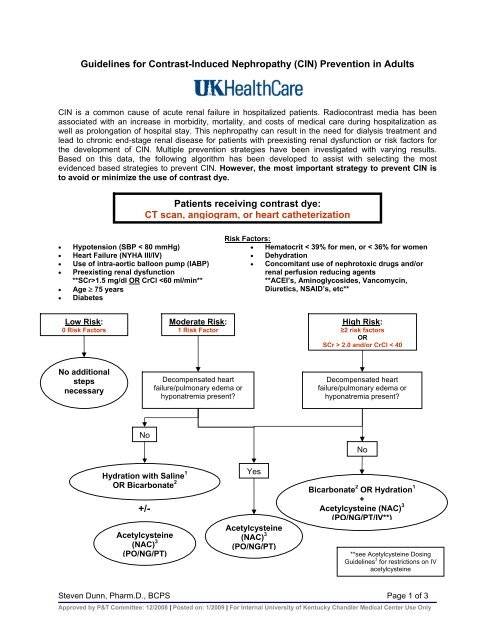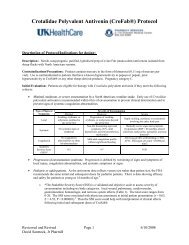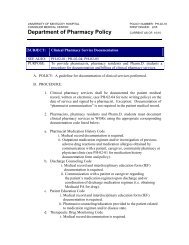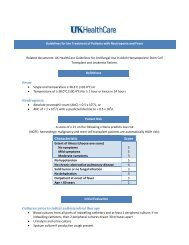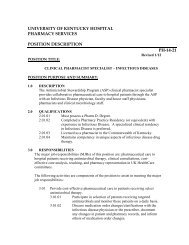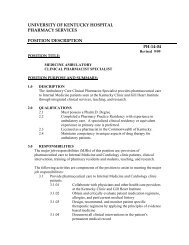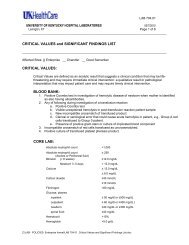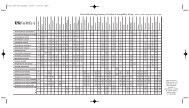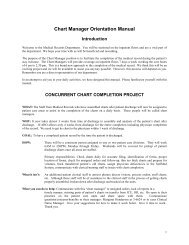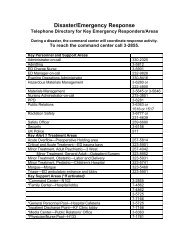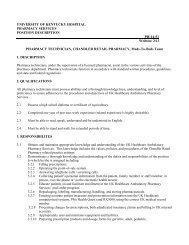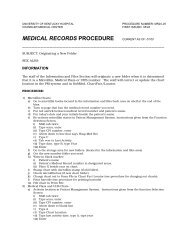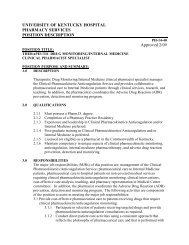Guidelines for Contrast-Induced Nephropathy - University of Kentucky
Guidelines for Contrast-Induced Nephropathy - University of Kentucky
Guidelines for Contrast-Induced Nephropathy - University of Kentucky
- No tags were found...
Create successful ePaper yourself
Turn your PDF publications into a flip-book with our unique Google optimized e-Paper software.
<strong>Guidelines</strong> <strong>for</strong> <strong>Contrast</strong>-<strong>Induced</strong> <strong>Nephropathy</strong> (CIN) Prevention in AdultsCIN is a common cause <strong>of</strong> acute renal failure in hospitalized patients. Radiocontrast media has beenassociated with an increase in morbidity, mortality, and costs <strong>of</strong> medical care during hospitalization aswell as prolongation <strong>of</strong> hospital stay. This nephropathy can result in the need <strong>for</strong> dialysis treatment andlead to chronic end-stage renal disease <strong>for</strong> patients with preexisting renal dysfunction or risk factors <strong>for</strong>the development <strong>of</strong> CIN. Multiple prevention strategies have been investigated with varying results.Based on this data, the following algorithm has been developed to assist with selecting the mostevidenced based strategies to prevent CIN. However, the most important strategy to prevent CIN isto avoid or minimize the use <strong>of</strong> contrast dye.Patients receiving contrast dye:CT scan, angiogram, or heart catheterization• Hypotension (SBP < 80 mmHg)• Heart Failure (NYHA III/IV)• Use <strong>of</strong> intra-aortic balloon pump (IABP)• Preexisting renal dysfunction**SCr>1.5 mg/dl OR CrCl 2.0 and/or CrCl < 40No additionalstepsnecessaryDecompensated heartfailure/pulmonary edema orhyponatremia present?Decompensated heartfailure/pulmonary edema orhyponatremia present?NoHydration with Saline 1OR Bicarbonate 2+/-Acetylcysteine(NAC) 3(PO/NG/PT)YesAcetylcysteine(NAC) 3(PO/NG/PT)NoBicarbonate 2 OR Hydration 1+Acetylcysteine (NAC) 3(PO/NG/PT/IV**)**see Acetylcysteine Dosing<strong>Guidelines</strong> 3 <strong>for</strong> restrictions on IVacetylcysteineSteven Dunn, Pharm.D., BCPS Page 1 <strong>of</strong> 3Approved by P&T Committee: 12/2008 | Posted on: 1/2009 | For Internal <strong>University</strong> <strong>of</strong> <strong>Kentucky</strong> Chandler Medical Center Use Only
1 Hydration with Saline <strong>Guidelines</strong>IVF = 1 mL/kg/hr (MAX 100 ml/hr) 12 hours pre & 12 hours post contrast* (24 hour total infusion duration)(*NS preferred IVF but MD can modify based on clinical status <strong>of</strong> patient)CHF or left ventricular ejection fraction (LVEF) < 40%?0.5 ml/kg/hr (max 50 ml/hr) 12 hrs pre & post contrast (24 hour total infusion duration)Emergent procedure? (suggested regimen):Fluid bolus <strong>of</strong> 500-1000 ml prior to procedure. Hydration during procedure and/or 12 hrs afterif possible (dependent on clinical status)2 Bicarbonate Dosing <strong>Guidelines</strong>IVF = 150 meq <strong>of</strong> sodium bicarbonate in 1 liter <strong>of</strong> D5W3 ml/kg bolus (MAX 300 ml) 1 hour prior to procedure AND 1 mL/kg/hour (MAX 100 ml/hr) during and <strong>for</strong> 6 hourspost-procedureGlycemic control issues (including patients with diabetes)?Consider mixing sodium bicarbonate in 1 liter <strong>of</strong> sterile water instead <strong>of</strong> D5W3 Acetylcysteine Dosing <strong>Guidelines</strong>Tolerating PO intake?600-1200 mg capsules PO Q12h X 4 doses2 doses pre-contrast and 2 doses post-contrast is optimalFeeding tube or NG-access?Acetylcysteine 600-1200 mg (3 mL <strong>of</strong> 20% soln.) liquid PT/NG Q12h x 4 doses totalEmergent Procedure?1 dose be<strong>for</strong>e and 3 doses post cath or procedure is acceptable (Q12h x 4 doses total)IV Acetylcysteine?600-1200 mg IV x 1 over 15 minutes, then 600-1200 mg PO/PT q12h x 4 doses post-procedure:For a high risk patient undergoing cardiac catheterization or PE protocol CT scan with no PO access**Monitor patient <strong>for</strong> anaphylactoid infusion reactions**IV Alternatives:• Ascorbic Acid 3 gm IV x1 dose 2 hours prior to procedure, then 2 gm IV BID x 2 doses post-procedure• Aminophylline 300 mg IV x1 (infused over 1 hour) prior to procedureSteven Dunn, Pharm.D., BCPS Page 2 <strong>of</strong> 3Approved by P&T Committee: 12/2008 | Posted on: 1/2009 | For Internal <strong>University</strong> <strong>of</strong> <strong>Kentucky</strong> Chandler Medical Center Use Only
References:1. Tepel M, van der Giet M, et al. Prevention <strong>of</strong> radiographic-contrast –induced reductions renalfunction by acetylcysteine. N Engl J Med 2000; 343: 180-184.2. Birck R, Krzossok S, et al. Acetylcysteine <strong>for</strong> prevention <strong>of</strong> contrast nephropathy: meta-analysis.Lancet 2003; 362: 598-603.3. Diaz-Sandoval LJ, Kosowsky BD, Losordo DW. Acetylcysteine to prevent angiography-relatedrenal tissue injury (the APART trial). Am J Cardiol 2002; 89: 356-358.4. Brophy D. Role <strong>of</strong> n-acetylcysteine in the prevention <strong>of</strong> radiocontrast induced nephropathy.Ann Pharmacother 2002; 36: 1466-1470.5. Durham JD, Caputo C, et al. A randomized controlled trial <strong>of</strong> N-acetylcysteine to prevent contrastnephropathy in cardiac angiography. Kidney Int 2002; 62: 2202-2207.6. Trivedi HL, Moore H, et al. A randomized prospective trial to assess the role <strong>of</strong> saline hydration onthe development <strong>of</strong> contrast nephrotoxicity. Nephron Clin Pract 2003; 93: c29-34.7. Mueller C, Buerkle G, et al. Prevention <strong>of</strong> contrast media-associated nephrotoxicity: randomizedcomparison <strong>of</strong> 2 hydration regimens in 1620 patients undergoing coronary angioplasty. Arch InternMed 2002; 162: 329-336.8. Merten GJ, Burgess WP, et al. Prevention <strong>of</strong> contrast-induced nephropathy with sodiumbicarbonate: a randomized controlled trial. JAMA. 2004;291:2328-34.9. Briguori C, Airoldi F, et al. Renal insufficiency following contrast media administration trial(REMEDIAL): a randomized comparison <strong>of</strong> 3 prevention strategies. Circulation. 2007;115:1-7.10. Barrett BJ, Pafrey PS. Preventing nephropathy induced by contrast medium. N Engl J Med.2006;354:379-86.11. Pannu N, Wiebe N, Tonelli M. Prophylaxis strategies <strong>for</strong> contrast-induced nephropathy. JAMA.2006;295:2765-79.12. Marenzi G, Assanelli, et al. N-acetylcysteine and contrast-induced nephropathy in primaryangioplasty. N Engl J Med. 2006;354:2773-82.13. Brar SS, Shen AYJ, Jorgensen MB, et al. Sodium bicarbonate vs sodium chloride <strong>for</strong> the prevention<strong>of</strong> contrast medium–induced nephropathy in patients undergoing coronary angiography. JAMA.2008;300:1038-46.14. Maioli M, Toso A, Leoncini M, et al. Sodium bicarbonate versus saline <strong>for</strong> the prevention <strong>of</strong> contrastinducednephropathy in patients with renal dysfunction undergoing coronary angiography orintervention. J Am Coll Cardiol. 2008;52:599-604.15. Navaneethan SD, Singh S, Appasamy S, et al. Sodium bicarbonate therapy <strong>for</strong> prevention <strong>of</strong>contrast-induced nephropathy: a systematic review and meta-analysis. Am J Kidney Dis. 2008.Steven Dunn, Pharm.D., BCPS Page 3 <strong>of</strong> 3Approved by P&T Committee: 12/2008 | Posted on: 1/2009 | For Internal <strong>University</strong> <strong>of</strong> <strong>Kentucky</strong> Chandler Medical Center Use Only


